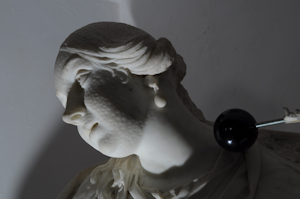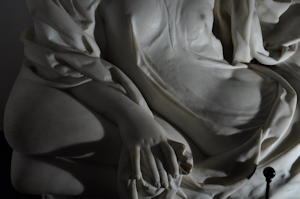
However, regarding the extent of the marks, one can see that the pocks are entirely confined to the face – the neck is completely innocent of them, as Figure 20 shows.

The strain of the disease most likely to end in fatality in Mary May's time is Variola major. Seventeenth-century England saw a steep rise in this strain, which begins with a rash on the face and spreads quickly over a few days across the rest of the body, developing into lesions (Hopkins 2002, 3). Virulent outbreaks of smallpox, as charted in the London Bills of Mortality, accounted for over 10% of non-plague deaths at times in 17th-century London (Carmichael and Silverstein 1987, 161). The resulting disfigurement for smallpox sufferers is documented in contemporary accounts, such as the poet John Dryden's helpful report of the death of Lord Hastings:
'Was there no milder way but the small-pox,
The very filthiness of Pandora's box?
So many spots, like naves on Venus' soil,
One jewel set off with so many a foil;
Blisters with pride swell'd, which through's flesh did sprout,
Like rose-buds, stuck i'the lily-skin about.
Each little pimple had a tear in it,
To wail the fault its rising did commit,
Which, rebel-like, with its own lord at strife,
Thus made an insurrection 'gainst his life.
Or were these gems sent to adorn his skin,
The cabinet of a richer soul within?
No comet need fortell his change drew on,
Whose corpse might seem a constellation.'
(cited in Grierson and Smith 2013, 174)
The tendency for smallpox survivors to be scarred principally on face and hands is well documented, although not fully understood (Anselment 1989, 84). For the smallpox victims that do not survive the virus, disfigurement is across the whole body, as Dryden's poem so graphically describes, but with density of pock-marks on the face, legs and arms. The lack of smallpox marks on the arms and neck of Mary May are therefore puzzling.
Figure 21 demonstrates the deliberate ending of the marks, which again firmly implies that they were nothing to do with Bushnell's much more sophisticated finishing. This raises interesting questions about the realism of the effigy.

Internet Archaeology is an open access journal based in the Department of Archaeology, University of York. Except where otherwise noted, content from this work may be used under the terms of the Creative Commons Attribution 3.0 (CC BY) Unported licence, which permits unrestricted use, distribution, and reproduction in any medium, provided that attribution to the author(s), the title of the work, the Internet Archaeology journal and the relevant URL/DOI are given.
Terms and Conditions | Legal Statements | Privacy Policy | Cookies Policy | Citing Internet Archaeology
Internet Archaeology content is preserved for the long term with the Archaeology Data Service. Help sustain and support open access publication by donating to our Open Access Archaeology Fund.